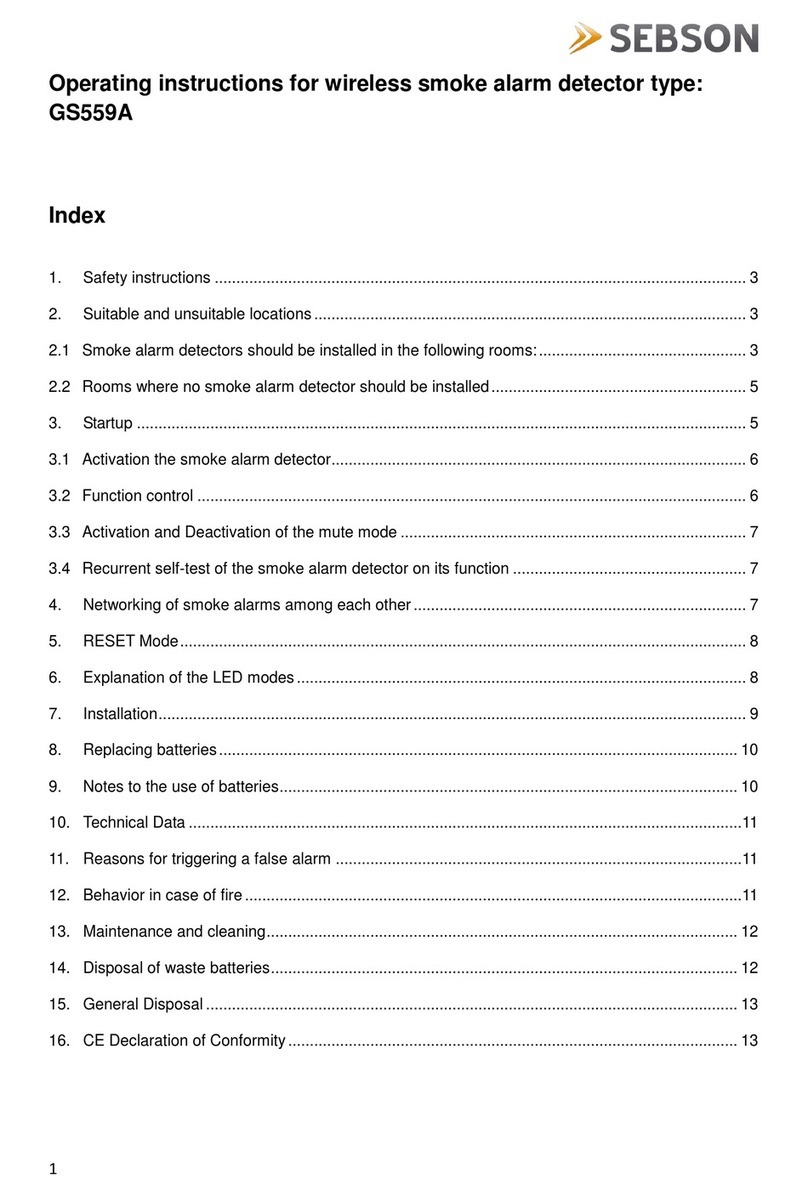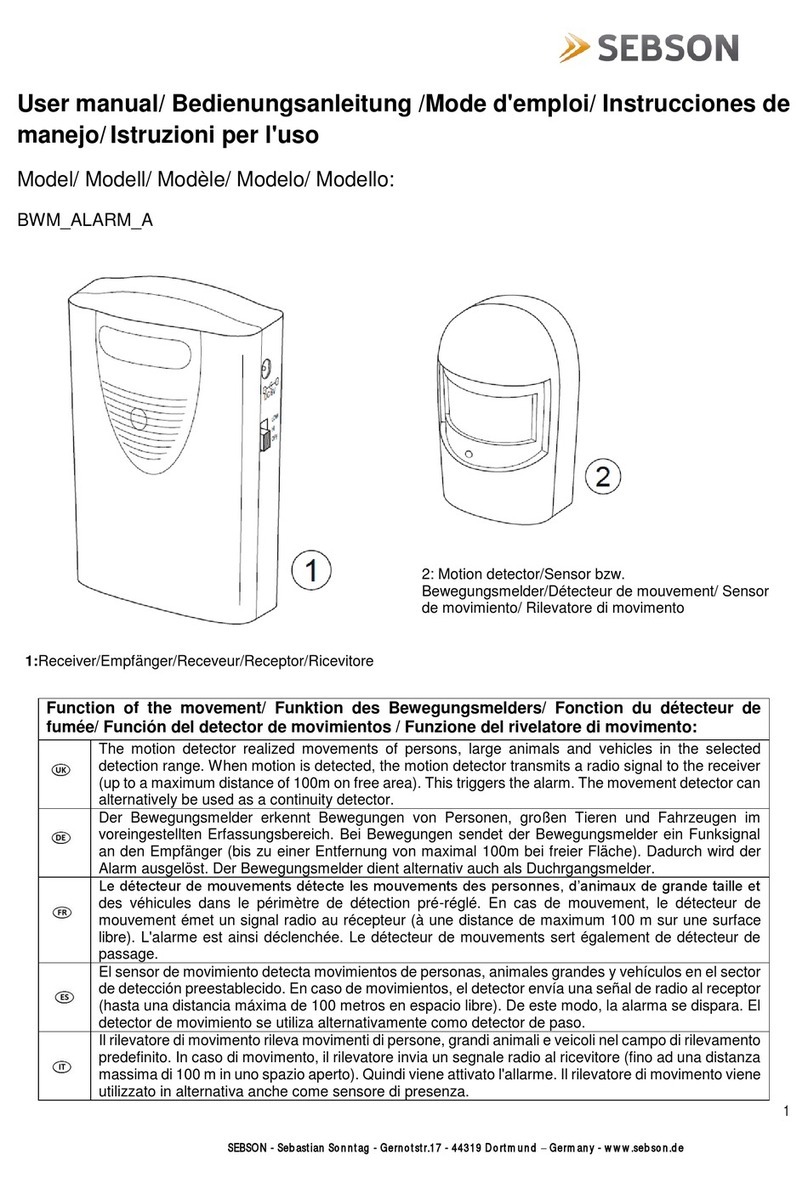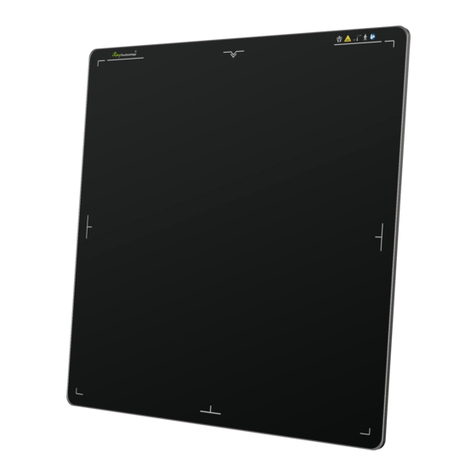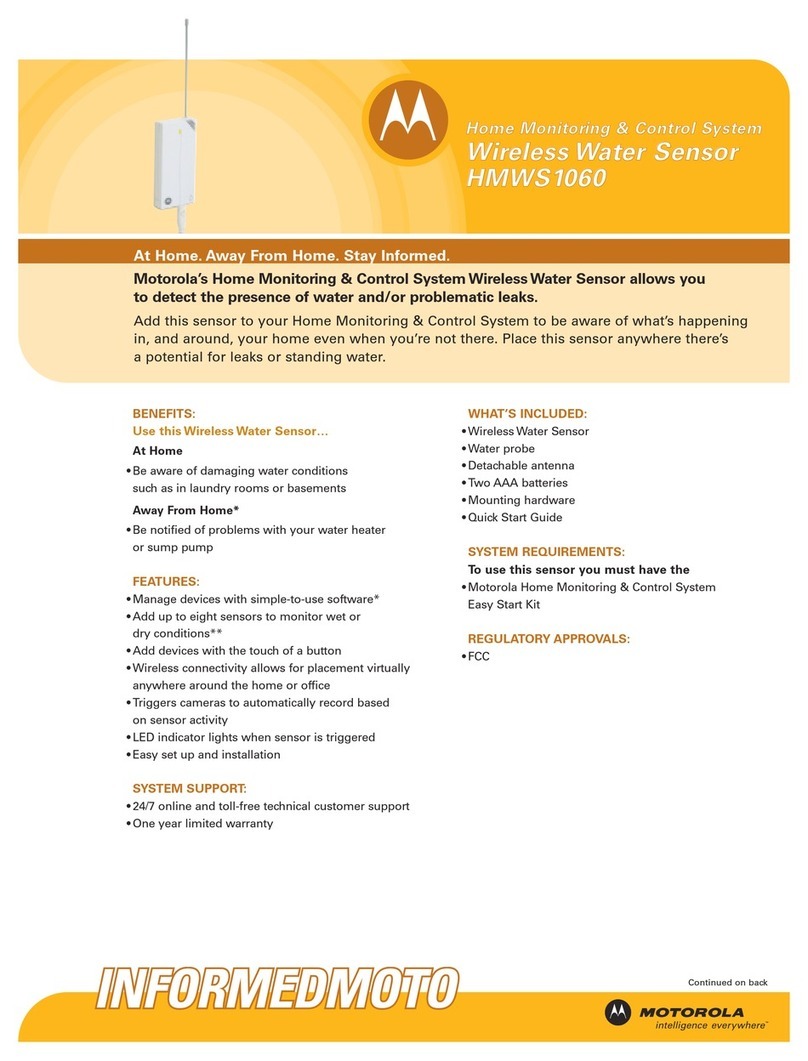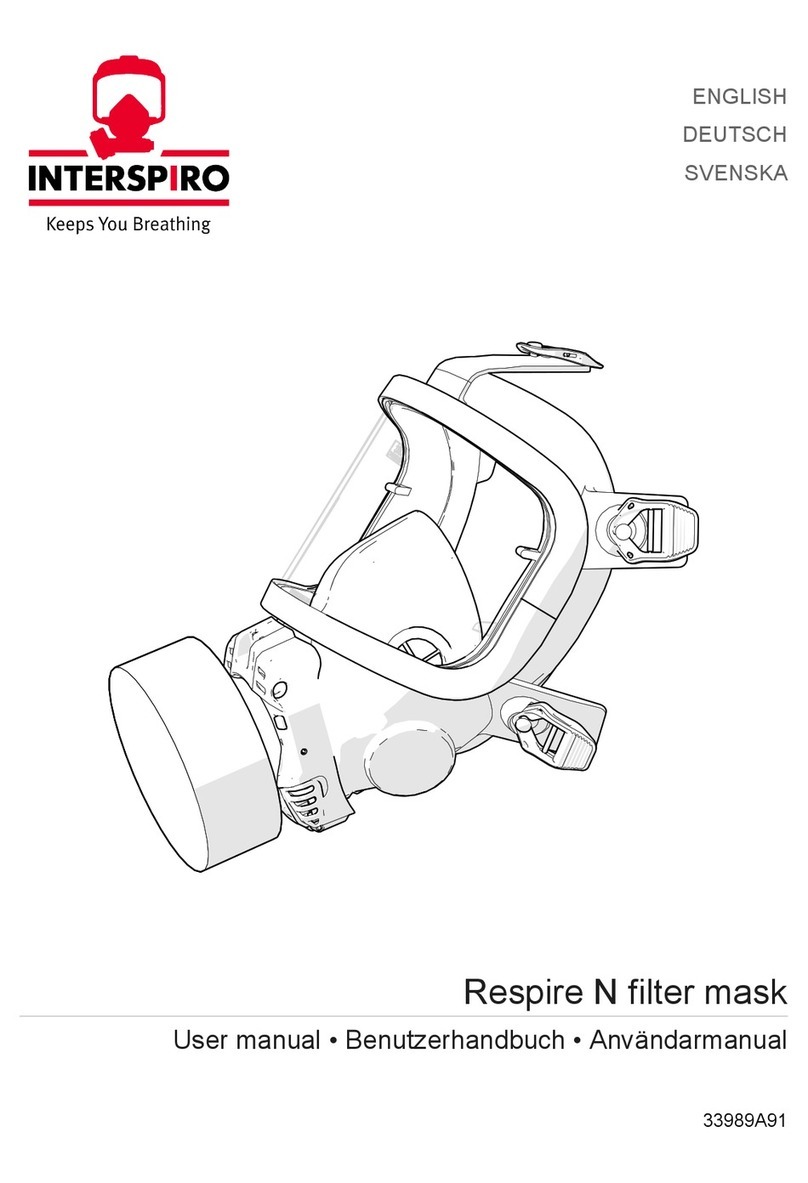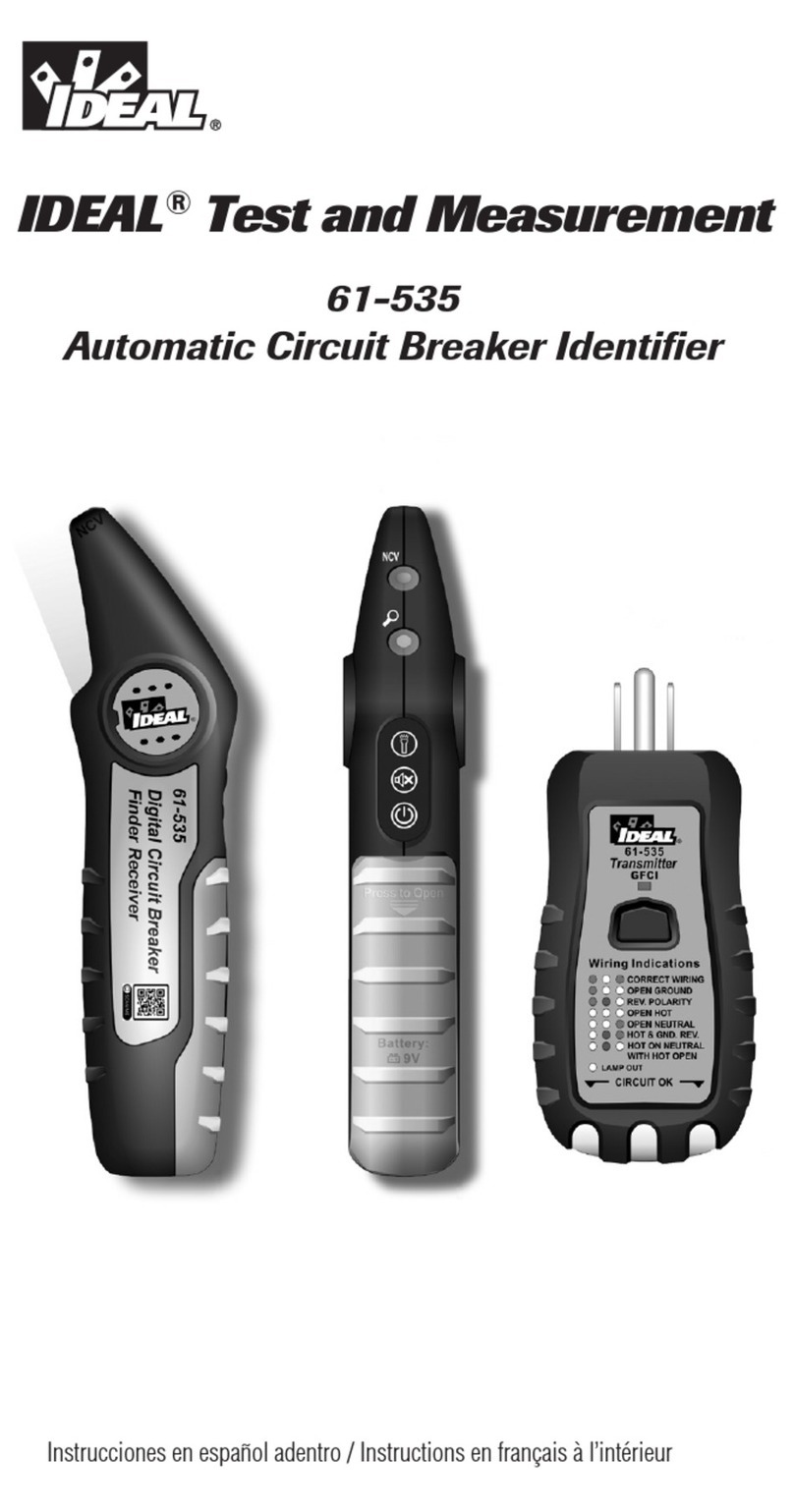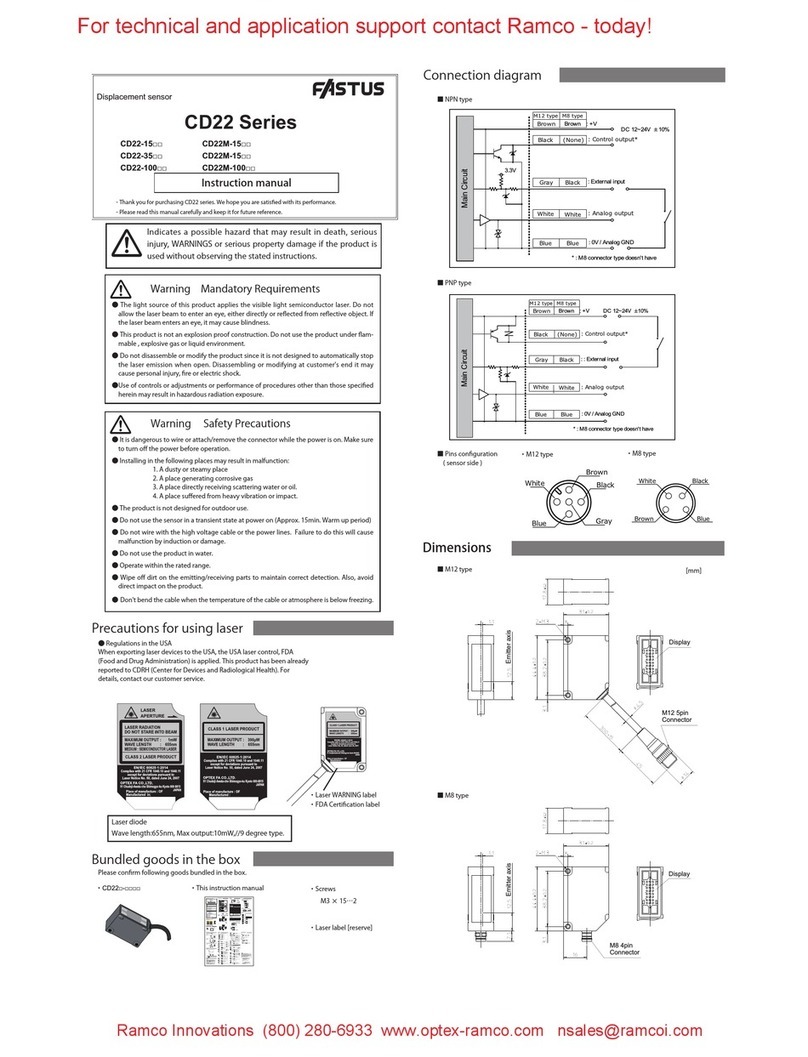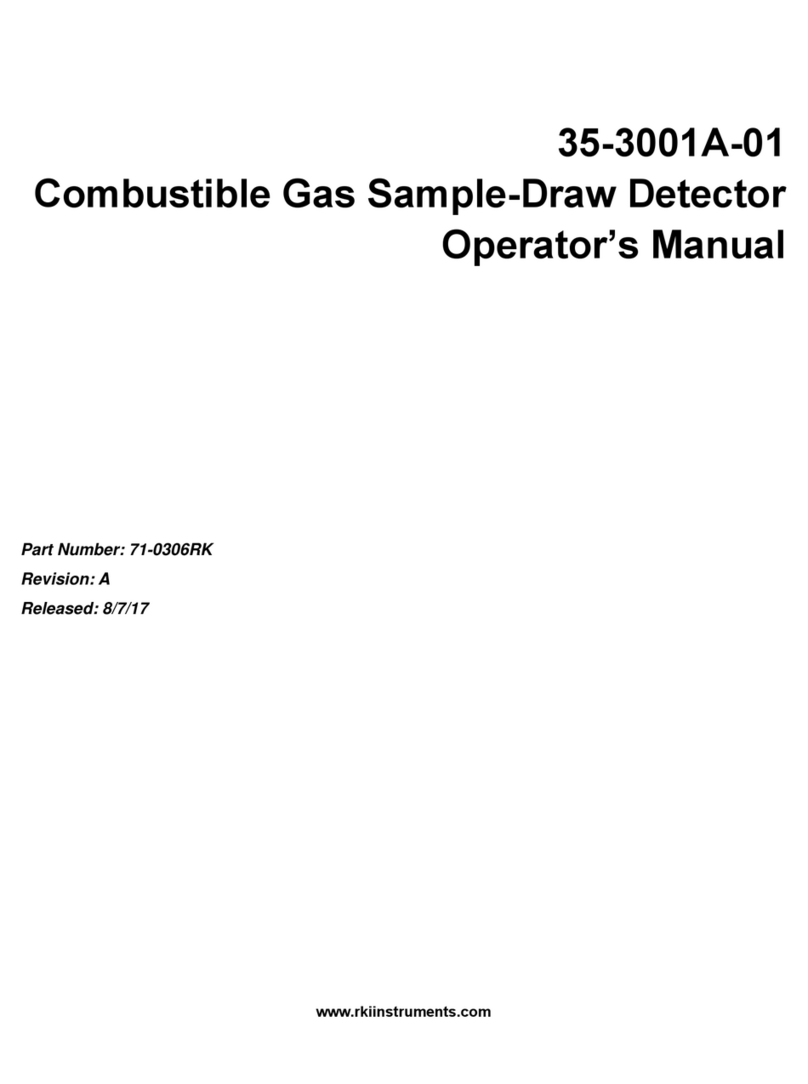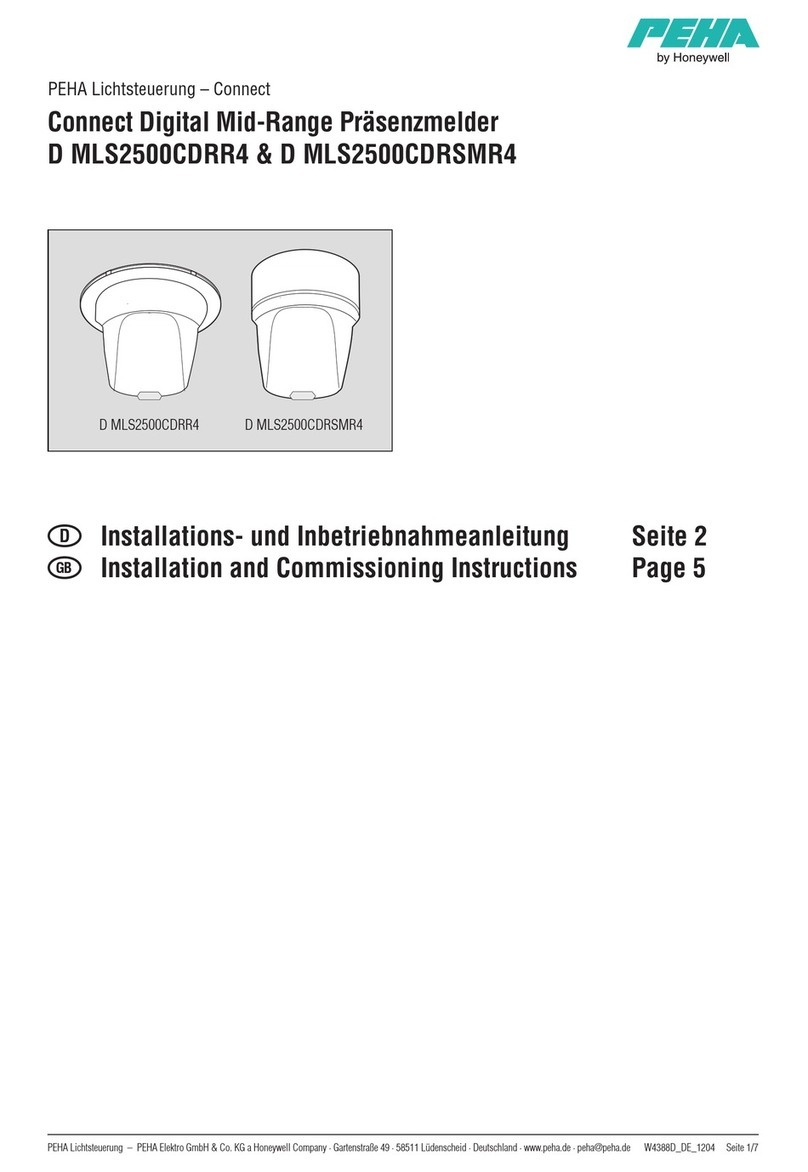SEBSON GS412 User manual

1
Operating instructions for the radio heat detector GS412
Index
1. Safety instructions ........................................................................................................................... 3
2. Suitable and unsuitable locations.................................................................................................... 3
2.1 Radio heat detectors should be installed in the following rooms:.................................................... 3
2.2 Rooms where no radio heat detector should be installed................................................................ 4
3. Startup ............................................................................................................................................. 5
3.1 Activation of the radio radio heat detector....................................................................................... 5
3.2 Function Control of the radio heat detector ..................................................................................... 6
3.3 Activation and Deactivation of the mute mode ................................................................................ 6
3.4 Recurrent self-test of the radio radio heat detector on its function.................................................. 7
4. Networking....................................................................................................................................... 7
5. RESET mode................................................................................................................................... 8
6. Explanation of the LED modes........................................................................................................ 8
7. Installation........................................................................................................................................ 8
8. Replacing batteries.......................................................................................................................... 9
9. Notes to the use of batteries............................................................................................................ 9
10. Technical Data................................................................................................................................ 10
11. Behavior in case of fire ................................................................................................................... 10
12. Maintenance and cleaning ..............................................................................................................11
13. Disposal of waste batteries..............................................................................................................11
14. General Disposal............................................................................................................................ 12
15. CE Declaration of Conformity......................................................................................................... 12

2
Thank you for choosing a product of SEBSON. Please read the instructions carefully and keep them
for looking up before start-up this product. A long and failure-free operation can only be guaranteed if
the installation and start-up is done properly.
Note: Please read all warnings and instructions before using this equipment!
This radio heat detector is used for early warning of dangerous heat development. As soon as an
ambient temperature of more than 54°C is reached, a loud alarm will sound and the LED will flash.
Radio heat detectors are particularly suitable for kitchens or rooms where strong smoking is
required.
This radio heat detector type GS412 may only be used in private rooms.
After a maximum of 10 years this device must be replaced.
Please note that this radio heat detector is not a substitute for smoke-alarm-, gas- or carbon
monoxide detector!
The radio heat detector can detect a fire early. The radio heat detector is not suitable for
preventing a fire!
This radio heat detector can be networked with the following devices: GS559A, GS412,
GS156A, GS816A, GS188
Scope of delivery:
Radio heat detector type: GS412
2 x 1,5V DC type: AA batteries
2 screws and 2 dowels
Model-number: GS412
Radio heat detector GS412

3
1. Safety instructions
Note: The alarm sound is very noisy! Your hearing can be damaged if you are exposed to the
loud alarm sound over a longer period of time!
Please do not paint over the radio radio heat detector with paint or similar!
Do not install the detector in difficult to access areas! The detector must be checked regularly
for its function!
Caution: Never test this device with an open flame, e.g. by a candle or a lighter! This will
damage the built-in sensor!
Get rid of the radio heat detector regularly (at least every six months) of dust and other
deposits of dirt! Please use a paint brush or a slightly cloth moistened with water. In dusty
conditions, the radio heat detector should be cleaned monthly.
This product is only suited for indoor-use and not for outdoor-use. Protect it against humidity
and moisture, splashing or dripping!
Damaged devices must be replaced immediately!
2. Suitable and unsuitable locations
2.1 Radio heat detectors should be installed in the following rooms:
Rooms are equipped with electrical appliances.
Bedrooms: If several bedrooms are in the house, then the attachment of radio heat detectors
in each bedroom are advised.
Corridors and stairways (At least one radio heat detector per floor)
Living and working rooms as well as in kitchens
Storage areas and garages
Rooms with fireplaces or wood stoves
Washing and drying rooms
Cellar and attic space: With the attic space a distance should be kept to the roof point of at
least 100cm (see Figure 1).
Figure 1: Mounting the radio heat detector on the roof slope
If the horizontal ceiling is less than 1 m wide, then the radio heat detector must be installed in
rooms with sloping ceilings as shown in Figure 2. If the ceiling is greater than 1m, then the radio
heat detector is placed on the horizontal ceiling

4
Figure 2: Mounting the radio heat detector on the ceiling ≤ 1m
Note: If you are unsure about the mounting of the radio heat detector in your rooms, please
advised by a qualified electrician!
The radio heat detector must be installed on the ceiling in the middle of the room, because heat
rises to the ceiling of the room and spread horizontally. The radio heat detector should be placed
possible so that this is at least 50cm from the side wall and 60cm mounted away from the corner
of the room. If you attach the radio heat detector to the wall, attach it approx. 30cm from the
ceiling (see Figure 3).
Figure 3: Mounting the radio heat detector on the ceiling or wall
On ceiling beams, which are thicker than 20 cm, no installation of radio heat detector should
be done. A minimum distance of 50 cm is urgently recommended.
The radio heat detector should be mounted at least 50 cm away from lamps and fluorescent
lamps.
An installation height of 6m maximum should not be exceeded. If the installation height is
more than 6m, the radio heat detector must be installed on several levels.
The radio heat detector can supervise a maximum area of 60m².
The maximum distance of radio heat detectors in extensive corridors can be up to 15 m. To
the end side of corridors the radio heat detectors should be applied in the distance of
maximum 7. 5 m.
In small corridors and rooms which are not wider than 1m, the radio heat detector must be
mounted in the middle of the ceiling.
2.2 Rooms where no radio heat detector should be installed
A radio heat detector in the kitchen should only be installed, if the distance to the stove is at
least 4m.
Radio heat detectors should not be installed close to heaters, heating-, cooling- and
ventilation-shafts. Also, they may not be mounted on open fires or fireplaces.

5
Do not install a radio heat detector in the immediate vicinity of doors and windows!
With A-shaped roofs the radio heat detectors may not be mounted at the highest point.
Rooms having a room temperature of below above 50°C.
3. Startup
Before starting up this product, please check for external damage. In case of visible external
damage we immediately dis-advise the start-up of this product! Please remove all packaging
material of this product before the first start-up.
3.1 Activation of the radio heat detector
Remove the mounting base by turning it clockwise (counterclockwise) and insert the batteries into
the battery compartment (see figure 4). If the batteries are inserted correctly (observe the polar
direction!), a short beep sounds and the LED lights up briefly. The radio heat detector is now
ready for use.
1. LED 2. TEST-button 3. Speaker

6
Figure 4: Battery case on the back of the radio heat detector
3.2 Function Control of the radio heat detector
To check the function, press and hold the TEST button. After pressing the key a very loud alarm
will sound! Keep the radio heat detector at least an arm's length away from your body while
pressing the TEST button. The alarm sounds at regular intervals 3 times in a row while the LED
flashed. In this case the function of the electronics, the alarm device of the radio heat detector and
the battery is checked. After releasing the TEST button, the alarm will turn off automatically. If the
alarm does not sound, replace the batteries! If the alarm does not sound even after replacing the
batteries, the radio heat detector must be replaced!
Attention: Test the radio heat detector weekly to its function by pressing the TEST button.
3.3 Activation and Deactivation of the mute mode
In a false alarm, which was not caused by a fire, the alarm can be switch off for about 10 minutes.
However you must absolutely make sure that the alarm was not activated by a fire! To temporarily
turn off the alarm, press the TEST button. While the radio heat detector is in mute mode, the LED
will flash every 8 seconds. Then open doors and windows to cool down the room. If the room
temperature is still too high after 10 minutes, the alarm sounds again. By pressing the test button,
the mute function can be repeated as often as desired. The mute function can be simply
deactivated by pressing again the start button. At an excessively heat development, this function is
not adjustable.

7
3.4 Recurrent self-test of the radio radio heat detector on its function
The radio heat detector performs every 32 seconds a self-test. You can see this by a short blink of
the LED.
Note: In case of improper function of the radio heat detector, please contact the manufacturer!
4. Networking
For networking, you need at least two networked devices. Each device is provided with a code by
the manufacturer. There are a total of over 60,000 encodings. If one device is connected to
another one, it will accept the code of the other. An already networked device, which is to be
connected to a new device, takes over the code of the new device. Please note that devices may
only be interlinked within an apartment or a family home! Note: Please connect only devices that
are not more than 35 meters apart! Please note that only devices from the same manufacturer can
be networked with each other!
Note: To prevent damage to your hearing, keep the device at least one arm's length away from
your body while pressing the TEST button!
1. Take a device that you want to network with another device and put it in the transmission
mode. Press the TEST button 3 times in succession. The LED lights up red for about 10
seconds continuously.
2. While the first device is in transmission mode for approximately 10 seconds (LED lights
continuously red), take another device and press the TEST button 3 times in succession. If a
short beep sounds and the LED flashes briefly, networking was successful.
3. In order to network additional devices with the first device, repeat steps 1 and 2 until all
devices are networked together.
4. Afterwards, check whether the devices are properly networked by carrying out a functional
check. Press and hold the TEST button on any networked device. If the alarm sounds on all
networked devices while you hold down the TEST button, the networking was successful. To
stop the function check, release the TEST button. The other devices stop beeping after a
maximum of one minute.
Attention: If the alarm sounds not on all devices, repeat the first two steps with the affected
device, and repeat the function check.
5. If the function check is unsuccessful again, perform a RESET (see chapter 5) of the device
and check the batteries. Then repeat the first two steps.

8
5. RESET mode
In order to perform a RESET, proceed as follows:
1. Remove the batteries.
2. Press and hold the TEST button while reinserting the batteries. Pay attention to the correct
polarity!
3. The LED lights solid red for about 3 seconds after inserting the batteries. Note: Keep and hold
the TEST button pressed!
4. When the LED light turns off, release the TEST button.
5. The LED light turns on. Press the TEST button again.
6. The RESET process is completed by a short beep sound.
6. Explanation of the LED modes
LED flashes every 32 seconds:
The radio heat detector is working properly.
LED flashes every second and alarm sounds:
TEST button is pressed or the alarm has been
triggered by heat.
LED flashes every 8 seconds:
The alarm is in the mute mode (see section
3.3).
LED flashes every 32 seconds and a short alarm
tone sounds:
Battery is low. The radio heat detector must be
replaced.
LED does not flash but the alarm sounds every
32 seconds:
The radio heat detector is not working
properly.
7. Installation
1. Disconnect the mounting base by turning it counterclockwise from the case.
2. Hold the mounting base to this position on the ceiling, where you want to mount the device.
Draw with a pencil the holes for the bores to the ceiling.
3. Then drill two holes (Ø 5mm).
4. Now take the two in the scope of delivery supplied dowels and put them in the bores.
5. Screw the mounting base to the ceiling. The screws are included in scope of delivery.
6. Through a short rotation of the housing clockwise and overcoming a slight resistance, the
radio heat detector can be securely fixed to the ceiling. The radio heat detector is now ready
for use.

9
8. Replacing batteries
The radio heat detector makes a recurring beep sound in 32 second intervals for 7 days.
Additionally the LED flashes. With this it points out that the battery must be changed. The radio
heat detector is still fully functional at this time. However, it is recommended to replace the battery,
as soon as the device is warning about the empty state of the battery! Note: The recurring
warning sound can be muted for about 10 hours by pressing the TEST button. After 10 hours, a
short warning tone sounds again every 32 seconds. Please always replace the battery with an
identical battery type, which is having the same technical specifications as the used battery. Never
use rechargeable batteries or power supplies for operation of the radio heat detector. These can
cause false alarms or lead to a complete failure of this product.
1. Turn the alarm case to the left, (against clockwise), and solve the housing from the mounting
plate.
2. Remove the old batteries.
3. Insert the new batteries into the battery compartment. Pay attention to the correct polarity!
4. Reattach the mounting base by turning it clockwise to the housing.
5. After replace the batteries please carry out a function-test by pressing the TEST-Button (see
chapter 3,2).
6. The radio heat detector is now ready for use again!
Attention: For safety reasons, please replace the batteries at least once a year!
9. Notes to the use of batteries
Non-rechargeable batteries are not to be re-charged!
New batteries should not be used together with used batteries. Please always use batteries
with the same type.
Please always pay attention to the correct polarity when inserting the battery!

10
The connection terminals never short-circuit!
Throw batteries never into the fire!
Keep batteries away from children and animals!
Please make sure that the batteries are not swallowed especially of infants. Here is danger to
life!
Dispose leaking batteries immediately as described in chapter: „ Disposal of waste batteries”.
Avoid in any case direct skin contact of leaking batteries. If you have come into contact with
battery acid, wash your hands immediately. Please make sure that the battery acid does not
come into contact with skin, eyes and / or mucous membranes!
10.Technical Data
Power supply: 2 x AA 1,5V DC batteries
Energy consumption: < 50μA (Stand-By), < 90mA (Alarm)
Alarm Volume: ≥ 85dB (A) within 3m
Radio frequency: 868MHz
Heat sensitivity: 54-70“C
Heat alarm signal local: Peep 0,5s –Pause 0,5s - Peep 0,5s –Pause 0,5s - Peep 0,5s
–Pause 1,5s LED flashes –Repetition of the signal
Radio alarm signal: Peep –Peep –Pause 1,2s –LED flashes –repetition of the
signal
Networking: Up to 15 networking alarm detectors of the same
manufacturer and product line
Radio range: Up to 100m (free field) Note: Please connect only devices that
are not more than 35 meters apart!
11.Behavior in case of fire
The installation of a heat or smoke alarm detector is only one of many fire protection measures.
Other fire protection measures are e.g. the provision of a fire extinguisher or a fire blanket Another
measure is the creation of an escape plan and the subsequent discussion with your roommates or
your family.
If the fire cannot be extinguished with a fire extinguisher or a fire blanket by yourself, then leave
the house immediately! Do not waste time to put clothes on or by transportation of personal
objects - because every second counts!
After leaving the house please inform the fire department immediately!
When leaving the burning room, please check first the surface of the door to its temperature.
Should the door be hot or under the door smoke rising up, do not open the door! If possibly please
use another door or a window to escape from the room. If the surface of the door is cold, then

11
brace yourselves with the shoulder against the door and open it a small gap. Be always careful
and ready to slam the door quickly, if heat or produced penetrates from the next door.
With strong production of smoke please keep close to the ground and breathe - if possibly -
through a cloth. Better still by a damp cloth!
You may enter the house again only after release or permission of the fire brigade!
12.Maintenance and cleaning
This device is maintenance free. Please remove the housing regularly from dirt, dust or spider
webs! For this, use the best vacuum cleaner with soft suction brush or a soft cleaning cloth.
Ensure that the housing and the air slots are free from contamination at all times, in order to
ensure proper functioning.
Note: Never open the housing to clean the unit from the inside. This can impair the functionality
and the warranty guarantee will be extinguished!
13.Disposal of waste batteries
Batteries and rechargeable batteries may not be disposed in the household waste.
The end-consumer are legally obligated to the return of all used batteries and/or
accumulators. After usage you can return batteries and / or accumulators gratuitous in
the sales point or in their direct vicinity (for example at municipal collection points and
trade). Otherwise, you can also return the batteries and / or accumulators by post to us: SEBSON
- Gernotstr.17-44319 Dortmund –Germany
Batteries and / or accumulators which contain harmful substances are marked with the symbol of a
crossed-out waste bin and may not be disposed of with household waste Under the dustbin
symbol is the chemical name of the harmful substance - in the example below - "CD" for cadmium,
"Pb" stands for lead, "HG" for mercury .
Meaning of symbols:
1 Battery containing more than 0,002 mass percent of cadmium
2 Battery containing more than 0,0005 mass percent of mercury
3 Battery containing more than 0,004 mass percent of lead
The harmful Substances which are contained in the batteries, may cause danger to health and the
environment in case of improper disposing.

12
14.General Disposal
This product may not be disposed of with household waste. At the end of its useful life,
the product must be returned to a point of acceptance for the recycling of electric and
electronic device. Please ask your local municipality for the point of acceptance! As the
devices contain valuable recyclable materials, they should be sent for recycling, in order
not to harm the environment or human health from uncontrolled waste disposal.
15.CE Declaration of Conformity
This product has been prepared according to the
listed below guidelines.
EMC 2014/30/EU
RoHS 2011/65/EU
R&TTE 1999/05/EC
SEBSON: Sebastian Sonntag - Gernotstr.17 - 44319 Dortmund –Germany - www.sebson.de
Table of contents
Other SEBSON Security Sensor manuals
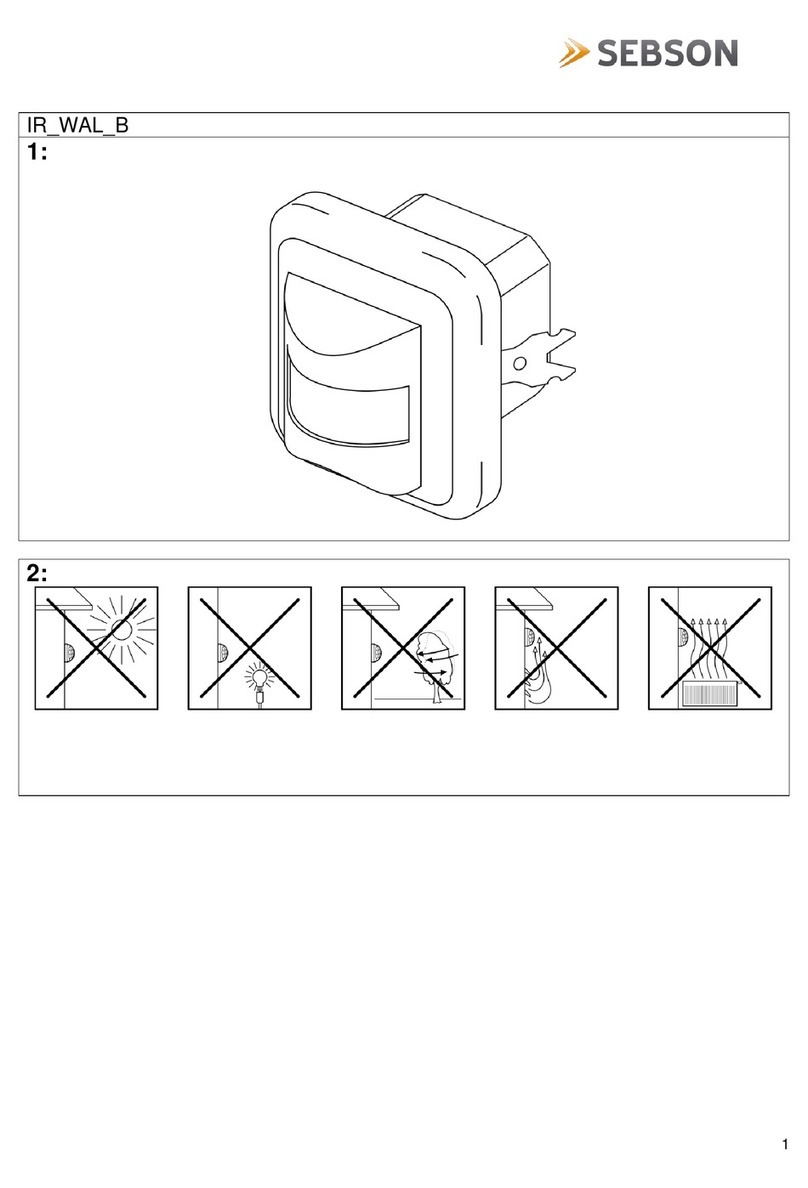
SEBSON
SEBSON IR WAL B User manual
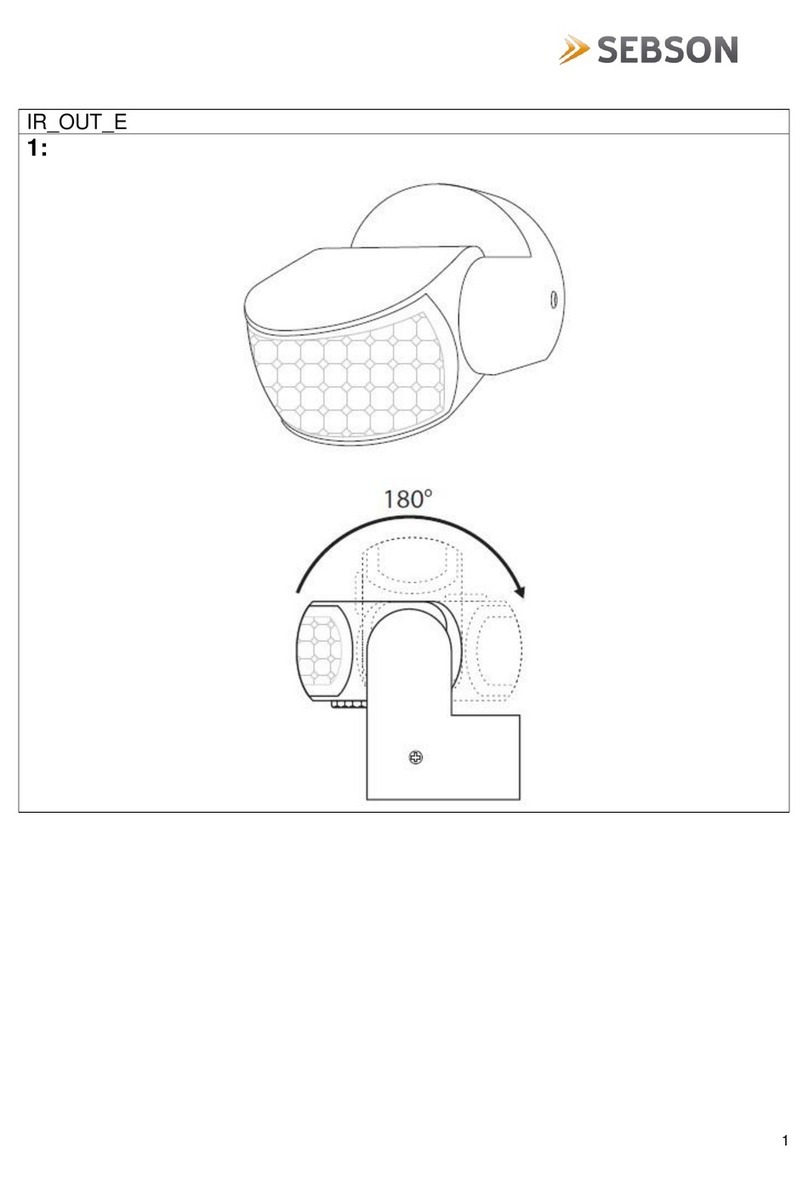
SEBSON
SEBSON IR_OUT_E User manual
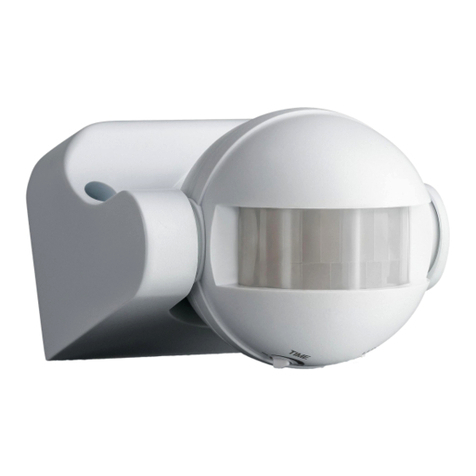
SEBSON
SEBSON IR OUT B User manual
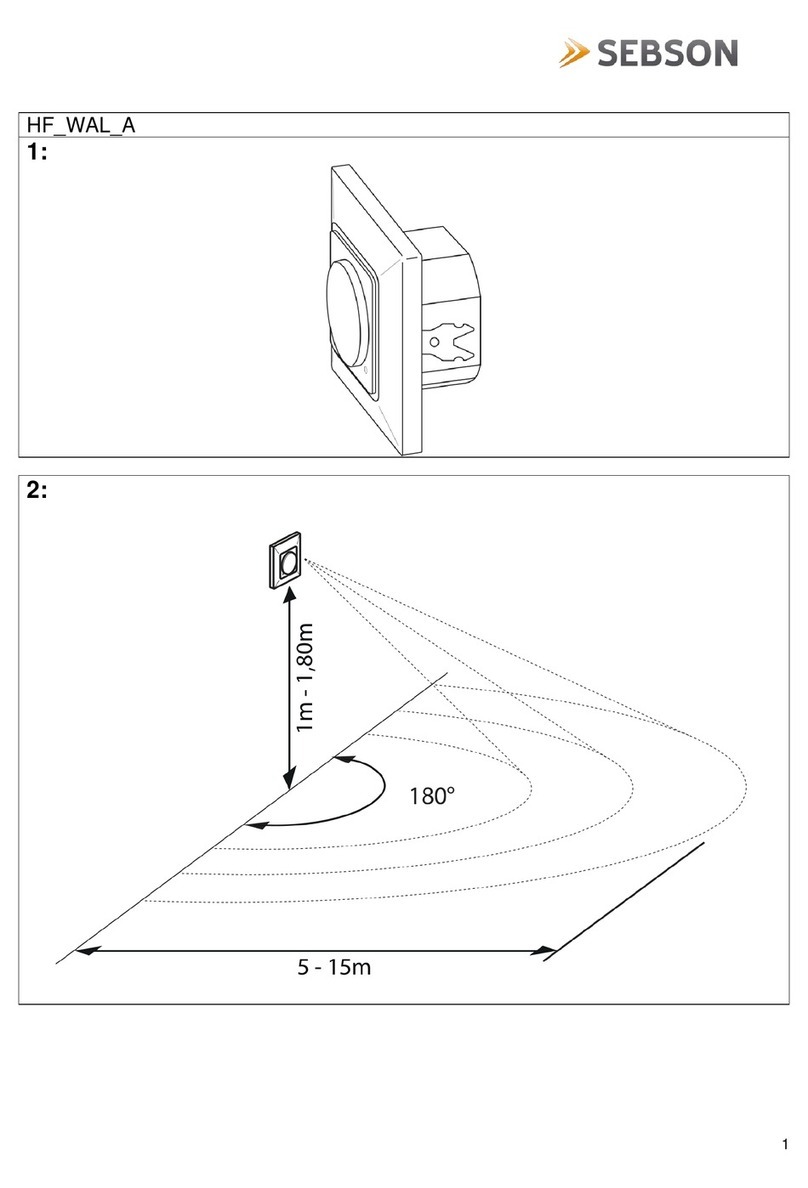
SEBSON
SEBSON HF WAL A User manual
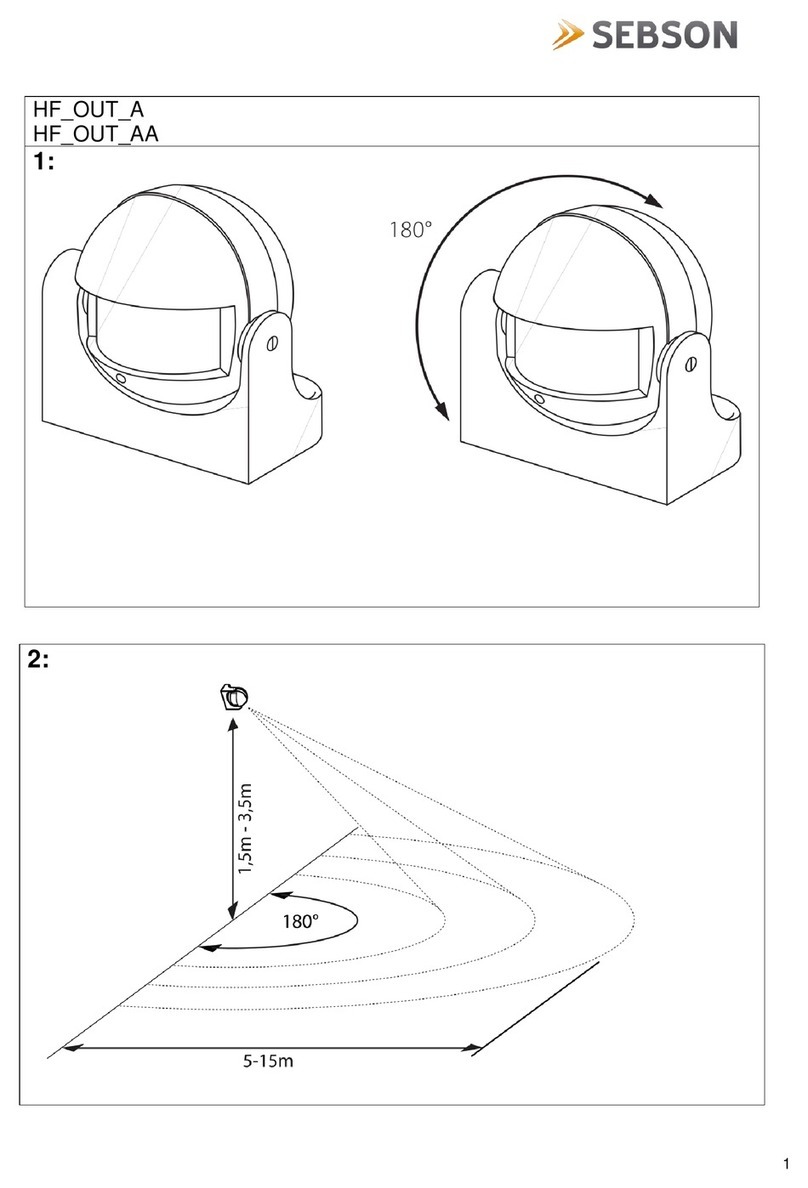
SEBSON
SEBSON HF OUT A User manual

SEBSON
SEBSON HD GS403 User manual

SEBSON
SEBSON GS403 User manual
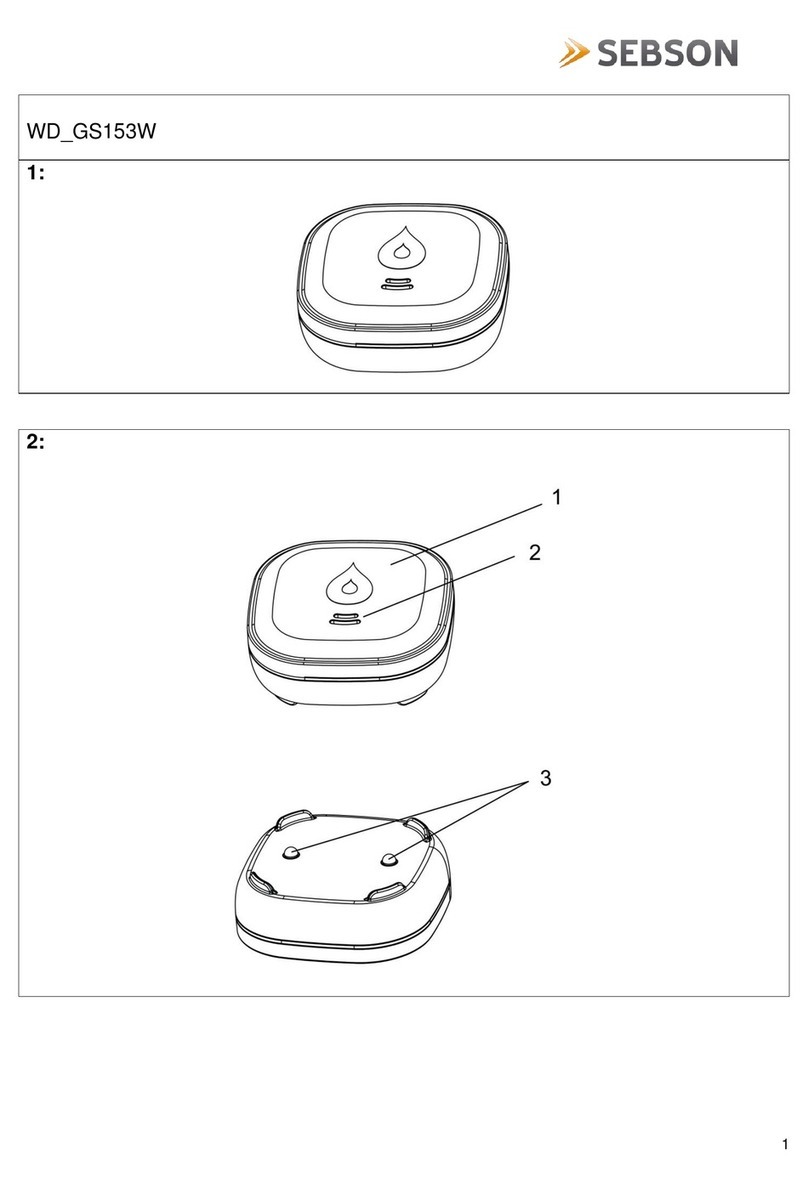
SEBSON
SEBSON WD GS153W User manual
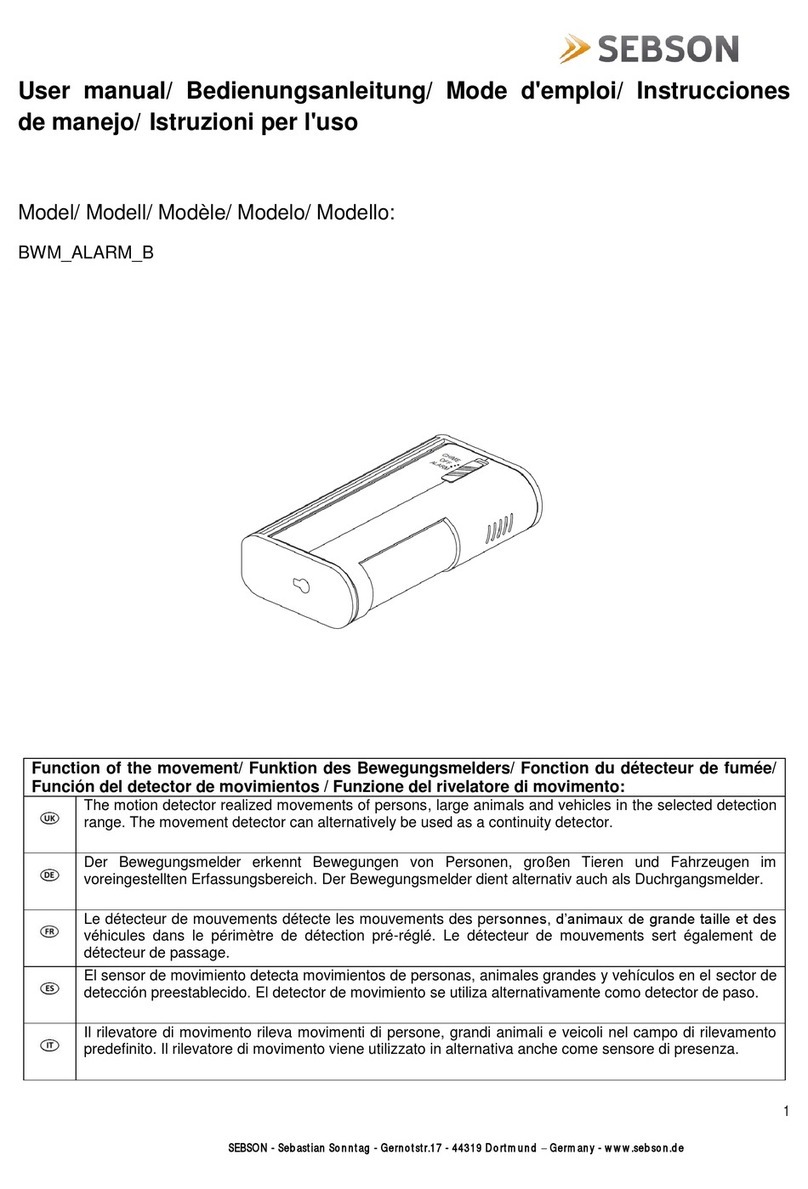
SEBSON
SEBSON BWM_ALARM_B User manual
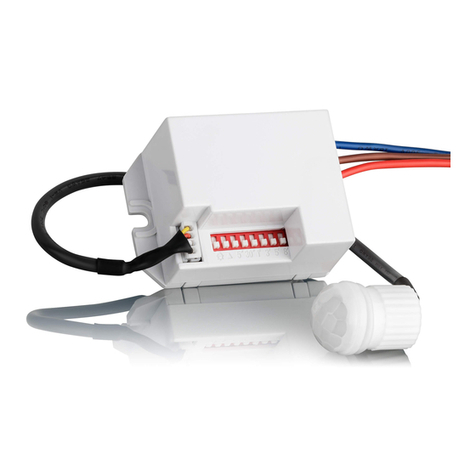
SEBSON
SEBSON IR BS A User manual
Popular Security Sensor manuals by other brands
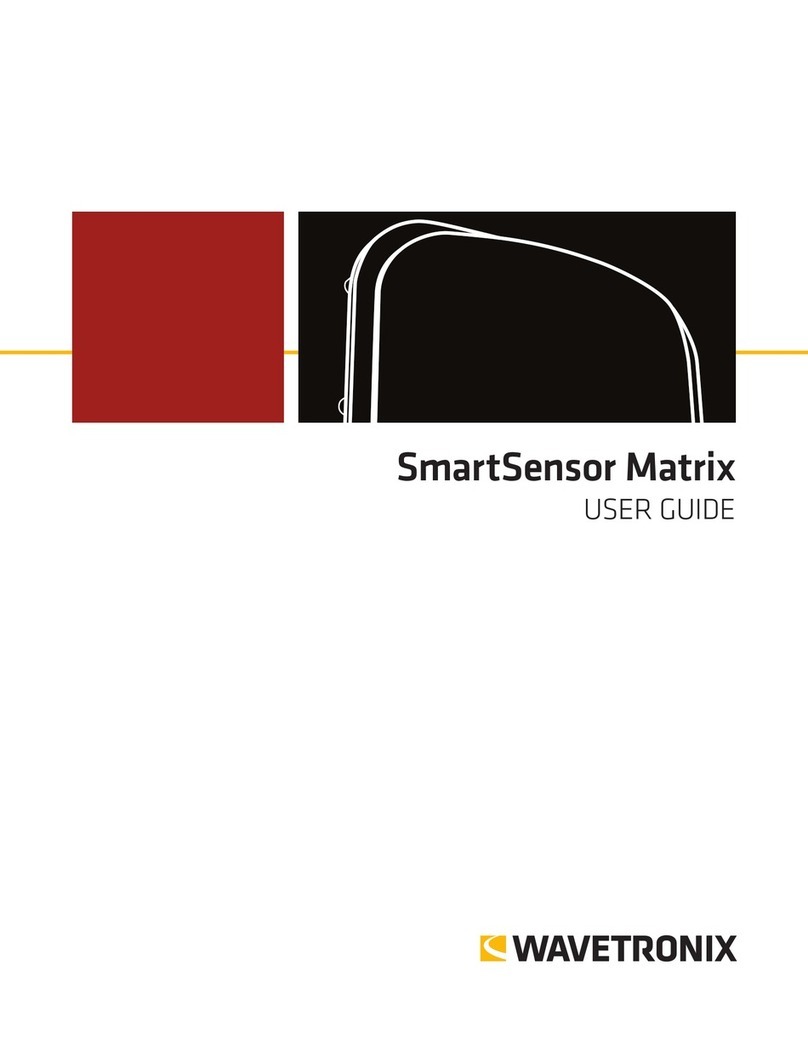
Wavetronix
Wavetronix SmartSensor Matrix user guide
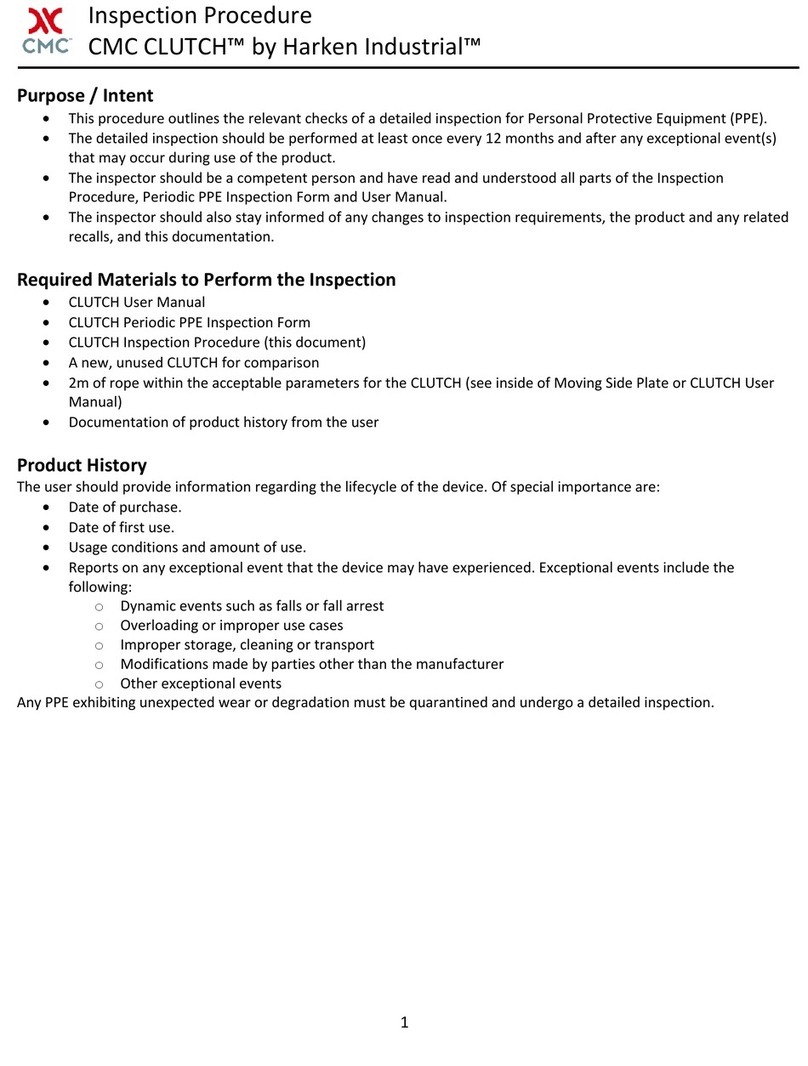
Harken Industrial
Harken Industrial CMC CLUTCH Inspection Procedure

Comelit
Comelit 41RCS100 Installation instruction
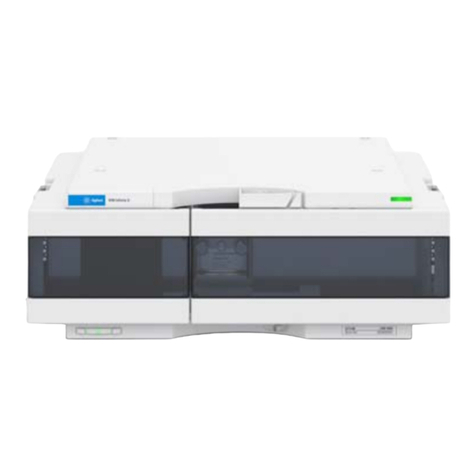
Agilent Technologies
Agilent Technologies InfinityLab LC Series user manual
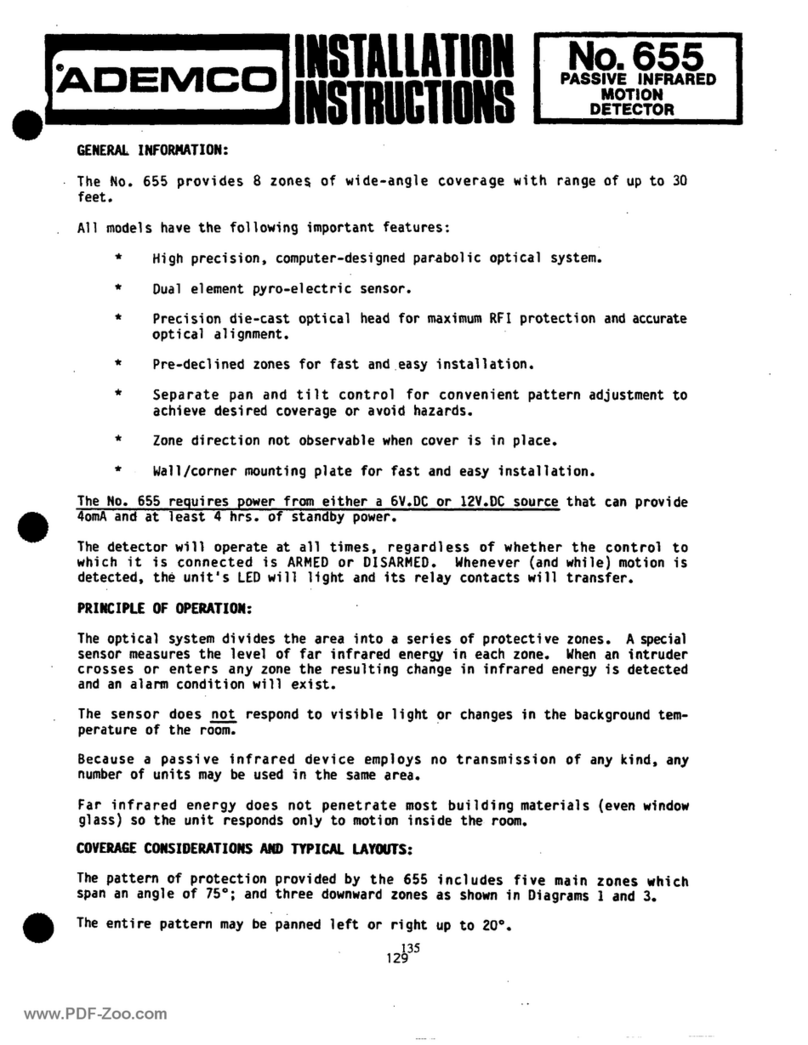
ADEMCO
ADEMCO 655 installation instructions

Rohm
Rohm BH1730FVC-TR Technical notes

